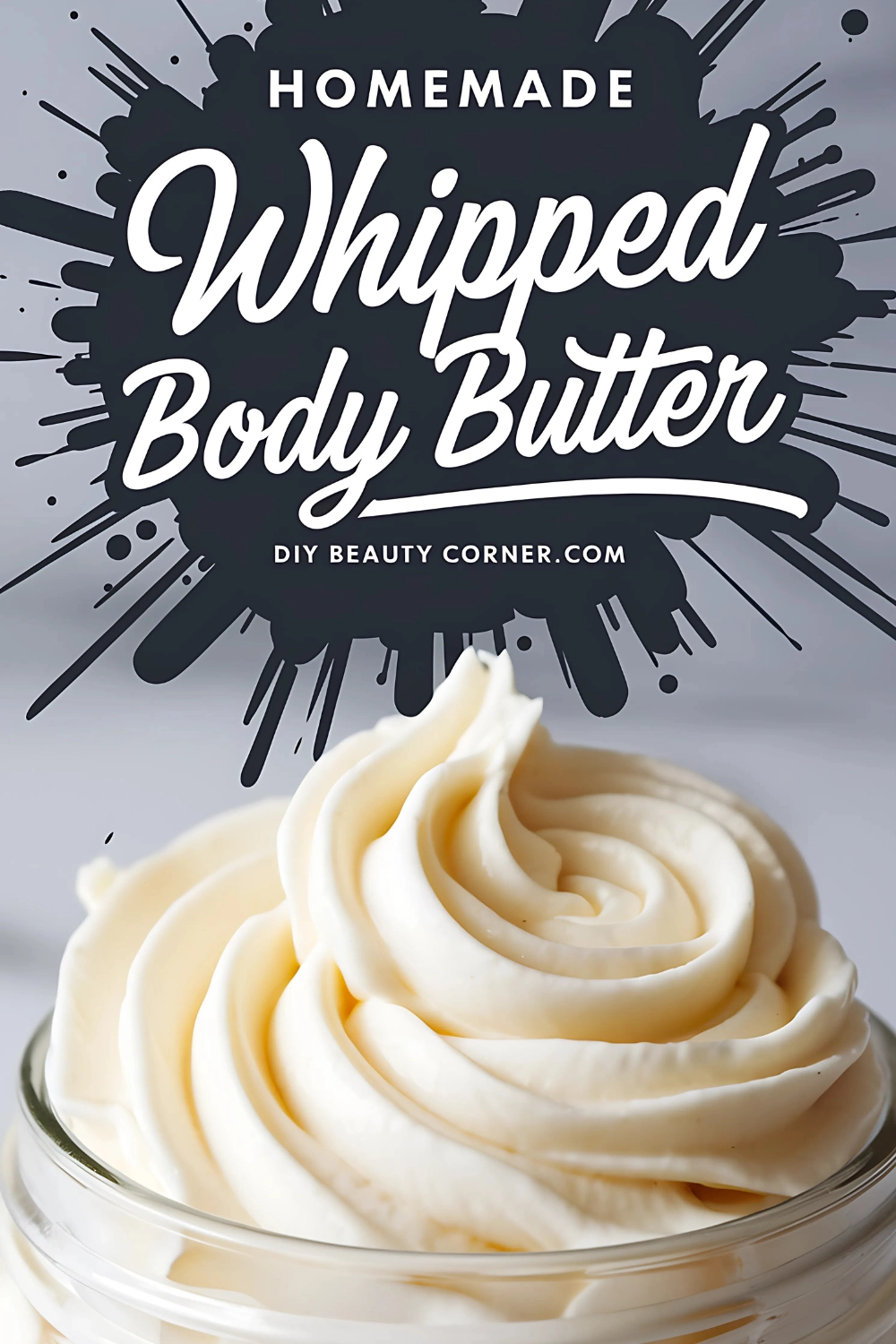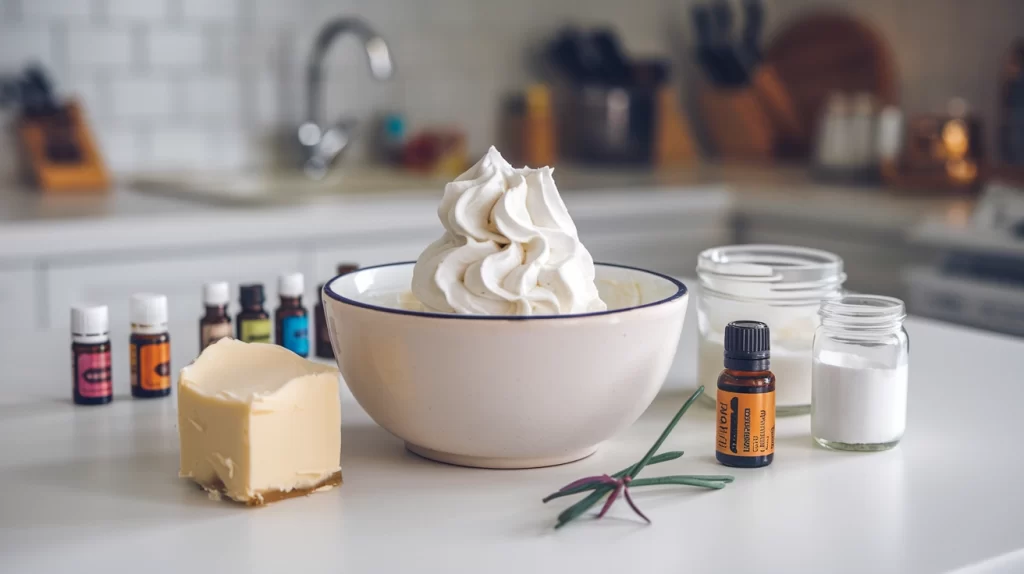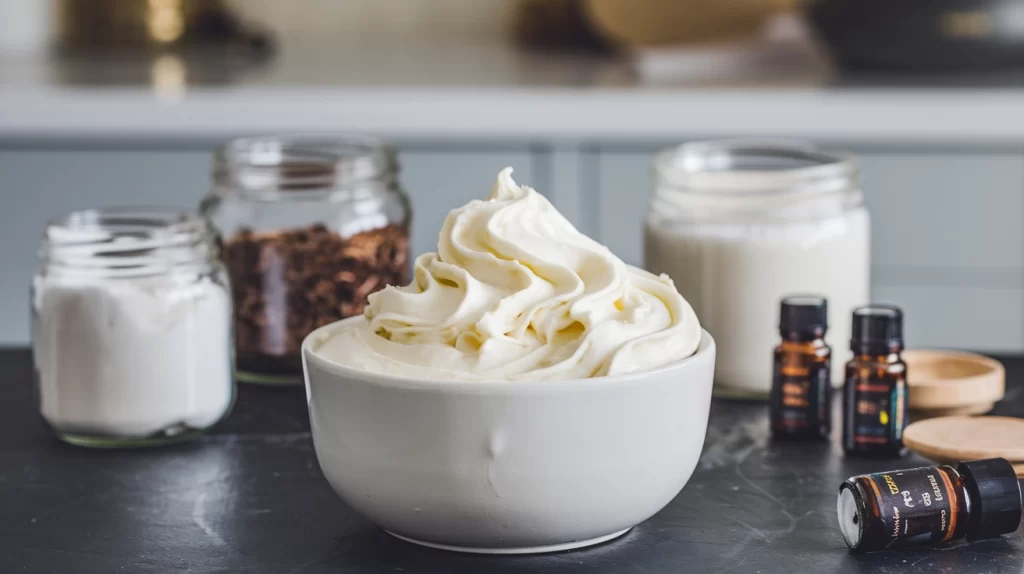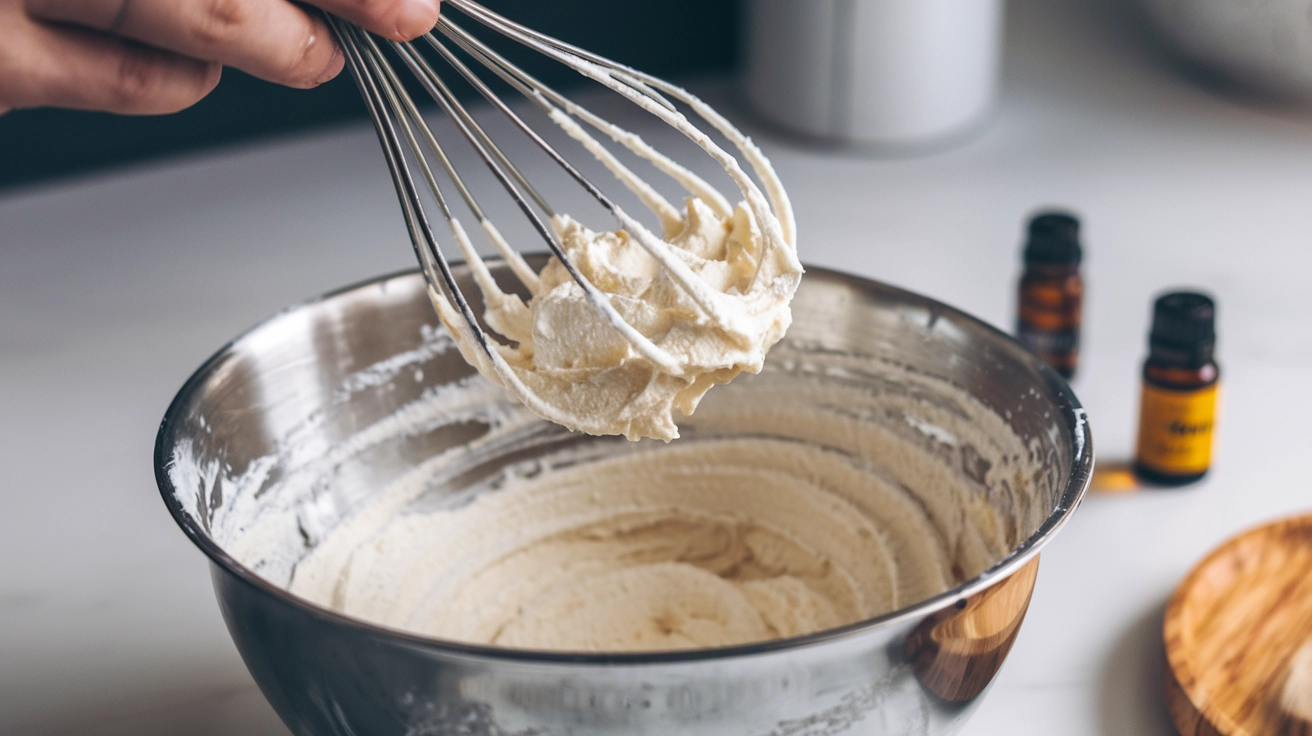Whipped body butter is a luxurious and nourishing skincare product that can be easily made at home. It is a great alternative to store-bought body lotions, which often contain chemicals and preservatives that can be harmful to the skin. Making your own whipped body butter allows you to customize the ingredients to suit your skin type and preferences, and it can also be a fun and rewarding DIY project.

To make whipped body butter, you will need a few basic ingredients, such as shea butter, cocoa butter, and carrier oils like coconut oil or sweet almond oil. Essential oils can also be added for fragrance and additional benefits. The process involves melting the ingredients together, allowing them to cool, and then whipping them until they reach a light and fluffy consistency.
There are many different recipes and variations of whipped body butter that can be found online, and it can be helpful to experiment with different ingredients and ratios to find the perfect formula for your skin. With a little bit of practice and patience, anyone can learn how to make whipped body butter at home and enjoy the benefits of this luxurious and nourishing skincare product.
Understanding Body Butter

Body butter is a luxurious moisturizer that can be used to hydrate and nourish the skin. It is thicker and more concentrated than regular lotion, making it ideal for dry and rough skin. Whipped body butter is a variation of body butter that has been aerated to give it a lighter and fluffier texture.
Benefits of Whipped Body Butter
Whipped body butter has several benefits for the skin. Some of the key benefits include:
-
Deep hydration: Whipped body butter is rich in natural oils and butters that penetrate deep into the skin to provide long-lasting hydration.
-
Nourishment: The natural ingredients in whipped body butter are packed with vitamins and nutrients that nourish the skin and promote healthy cell regeneration.
-
Softness: Whipped body butter has a light and fluffy texture that makes it easy to apply and absorb into the skin, leaving it feeling soft and smooth.
-
Protection: The natural oils and butters in whipped body butter form a protective barrier on the skin that helps to prevent moisture loss and protect against environmental damage.
Key Ingredients Explained
Whipped body butter is made using natural ingredients that are beneficial for the skin. Some of the key ingredients used in whipped body butter include:
-
Natural butter: Natural butters such as shea, mango, and cocoa butter are rich in fatty acids and vitamins that nourish and hydrate the skin.
-
Carrier oil: Carrier oils such as coconut, almond, and jojoba oil are lightweight oils that help to moisturize and protect the skin.
-
Essential oil: Essential oils such as lavender, peppermint, and tea tree oil are added to whipped body butter for their therapeutic properties and natural fragrance.
-
Thickening starch: Thickening starch such as arrowroot or cornstarch is added to whipped body butter to give it a light and fluffy texture.
By understanding the benefits and key ingredients of whipped body butter, you can make an informed decision about whether it is the right moisturizer for your skin.
Gathering Your Materials

Tools and Equipment
Before starting with the process of making whipped body butter, it’s important to make sure that you have all the necessary tools and equipment. Some of the essential tools you’ll need include:
- Double boiler or a heatproof bowl and a saucepan
- Whisk or an electric mixer
- Measuring cups and spoons
- Spatula
- Airtight containers for storing the body butter
Having these tools and equipment at hand will make the process of making whipped body butter much easier and efficient.
Choosing Your Butters and Oils
The key to making a high-quality whipped body butter is selecting the right ingredients. When it comes to choosing the butters and oils, there are several options available, each with its own unique properties and benefits. Some of the popular options include:
-
Shea butter: Shea butter is a popular choice for making whipped body butter due to its moisturizing and nourishing properties. It’s rich in vitamins A and E, and has anti-inflammatory properties that can help soothe irritated skin.
-
Cocoa butter: Cocoa butter is another excellent option for making whipped body butter. It’s high in fatty acids, which can help improve skin elasticity and hydration. It also has antioxidant properties that can help protect the skin from free radicals.
-
Coconut oil: Coconut oil is a versatile oil that can be used in a variety of skincare products, including whipped body butter. It’s high in lauric acid, which has antimicrobial properties that can help fight acne and other skin infections.
-
Jojoba oil: Jojoba oil is a lightweight oil that’s easily absorbed by the skin. It’s high in vitamins E and B, and has anti-inflammatory properties that can help soothe and calm irritated skin.
By selecting the right combination of butters and oils, you can create a whipped body butter that’s perfect for your skin type and needs.
The Basic Recipe

Ingredient Ratios
To make whipped body butter, the basic ingredient ratios are 1 part solid butter to 1 part liquid oil. The solid butter can be any of the following: shea butter, cocoa butter, mango butter, or a combination of these. The liquid oil can be any carrier oil such as jojoba oil, almond oil, coconut oil, or olive oil. The ratio of essential oils to the body butter can be 1-2% of the total weight of the butter and oil.
Step-by-Step Instructions
- Melt the solid butter and liquid oil in a double boiler or a glass bowl over a pot of simmering water.
- Once melted, remove from heat and allow the mixture to cool to room temperature.
- Add any desired essential oils to the mixture and stir well.
- Place the mixture in the refrigerator for 15-20 minutes until it begins to solidify.
- Using a hand mixer or stand mixer, whip the mixture until it becomes light and fluffy.
- Transfer the whipped body butter to a clean, airtight container and store in a cool, dry place.
It’s important to note that the ratio of solid butter to liquid oil can be adjusted to suit personal preferences. A higher ratio of solid butter will result in a thicker, more luxurious body butter, while a higher ratio of liquid oil will result in a lighter, more easily absorbed body butter. Additionally, the essential oils used can be adjusted to create a customized scent or to provide specific benefits to the skin.
Customizing Your Body Butter

When making whipped body butter, there are many ways to customize the final product to your liking. Here are some ways to make your whipped body butter unique:
Adding Scents
Adding scents to your whipped body butter is a great way to make it smell amazing and enhance your overall experience. Essential oils are a popular choice for scenting body butter because they are natural and have many benefits for the skin. Some popular essential oils for body butter include lavender, peppermint, and citrus oils.
To add scent to your whipped body butter, simply add a few drops of your desired essential oil to the mixture before whipping it. Be sure to start with a small amount and adjust as needed to achieve the desired scent.
Incorporating Colors
While whipped body butter is typically white or off-white in color, there are ways to incorporate colors into your final product. Natural colorants like cocoa powder, beetroot powder, and turmeric can be added to give your whipped body butter a unique hue.
To incorporate color into your whipped body butter, add a small amount of the desired colorant to the mixture before whipping it. Be sure to start with a small amount and adjust as needed to achieve the desired color.
Adjusting Texture
The texture of whipped body butter can be adjusted to your liking by altering the ratio of oils and butters used in the recipe. If you prefer a lighter, more whipped texture, use more oils and less butter. If you prefer a thicker, more luxurious texture, use more butter and less oil.
Another way to adjust the texture of whipped body butter is to add a thickening agent like arrowroot powder or cornstarch. This will give your body butter a thicker, more spreadable texture.
In conclusion, customizing your whipped body butter is a fun and easy way to make it unique to your preferences. Whether you want to add scent, incorporate color, or adjust the texture, there are many ways to make your whipped body butter your own.
Whipping Technique

Whipping is a crucial step in making whipped body butter. It is what gives the butter its light, fluffy texture. Here are some tips to achieve the perfect consistency and troubleshoot common issues.
Achieving Perfect Consistency
To achieve the perfect consistency, it is important to use the right tools. A hand mixer or stand mixer is recommended for best results. A whisk or fork can also be used, but it will take longer to achieve the desired texture.
When whipping the butter, start on low speed and gradually increase to high speed. This will prevent the butter from splattering and ensure that it is evenly whipped. It is important not to over-whip the butter, as this can cause it to become grainy or separate.
To test if the butter is ready, take a small amount and rub it between your fingers. If it feels light and fluffy, it is ready. If it feels greasy or grainy, continue whipping until it reaches the desired consistency.
Troubleshooting Common Issues
If the butter becomes grainy or separates during whipping, it may be due to the temperature of the ingredients. Make sure that the butter and oil are at room temperature before whipping. If the butter is too cold, it will not whip properly. If it is too warm, it will become greasy and will not hold its shape.
Another common issue is over-whipping the butter. This can cause it to become grainy or separate. If this happens, try adding a small amount of melted butter or oil and continue whipping until it reaches the desired consistency.
In conclusion, whipping is a crucial step in making whipped body butter. By following these tips, you can achieve the perfect consistency and troubleshoot common issues to create a light and fluffy butter that nourishes and moisturizes the skin.
Preservation and Storage

Extending Shelf Life
To extend the shelf life of whipped body butter, it is important to use a preservative. Some natural preservatives that can be used include vitamin E oil, rosemary extract, and grapefruit seed extract. These preservatives help to prevent the growth of bacteria and fungi in the product, which can cause it to spoil.
It is important to note that even with a preservative, whipped body butter will still have a limited shelf life. The exact shelf life will depend on the specific ingredients used, as well as storage conditions. It is recommended to use the product within 3-6 months of making it.
Proper Storage Methods
Proper storage is also important for extending the shelf life of whipped body butter. It should be stored in a cool, dry place away from direct sunlight. If the product is exposed to heat or sunlight, it can cause the oils to separate and the product to spoil more quickly.
It is also recommended to store whipped body butter in an airtight container to prevent air and moisture from getting in. This can help to prevent the growth of bacteria and fungi in the product, which can cause it to spoil more quickly.
In summary, to extend the shelf life of whipped body butter, it is important to use a natural preservative and store it in a cool, dry place away from direct sunlight in an airtight container.
Application Tips

Best Practices for Use
When applying whipped body butter, it is best to start with a small amount and gradually add more as needed. This will help prevent the butter from feeling too heavy or greasy on the skin. It is also important to apply the butter to clean, dry skin for optimal absorption.
To ensure maximum benefits, it is recommended to apply whipped body butter immediately after showering or bathing. This will help lock in moisture and keep the skin feeling soft and supple throughout the day.
Skin Types and Application Methods
Whipped body butter is suitable for all skin types, from dry to oily. For those with dry skin, it is best to apply the body butter more liberally, focusing on areas that are prone to dryness, such as elbows, knees, and feet.
For those with oily skin, it is recommended to apply the body butter sparingly, focusing on areas that tend to be drier, such as the hands and feet. It is also important to choose a body butter that is lightweight and non-greasy.
When applying whipped body butter, it is important to massage it into the skin in circular motions until fully absorbed. This will help promote circulation and enhance the skin’s natural glow.
Overall, whipped body butter is a versatile and nourishing skincare product that can help keep the skin feeling soft, smooth, and hydrated. By following these application tips, users can maximize the benefits of this luxurious product.
Frequently Asked Questions
What are the essential ingredients needed for making whipped body butter?
The essential ingredients for making whipped body butter include a butter base such as shea butter or cocoa butter, a carrier oil such as coconut oil or jojoba oil, and essential oils for fragrance and added benefits. Other optional ingredients include vitamin E oil and arrowroot powder.
Can whipped body butter be made without using shea butter, and if so, how?
Yes, whipped body butter can be made without using shea butter. Some alternative options include using cocoa butter, mango butter, or avocado butter as the base. The process for making whipped body butter without shea butter is similar to the process of making it with shea butter.
What are the best essential oils to add to homemade body butter?
The best essential oils to add to homemade body butter depend on personal preference and the desired benefits. Some popular options include lavender for relaxation, peppermint for a cooling effect, and tea tree oil for its antibacterial properties. It’s important to research the benefits and safety precautions of each essential oil before adding it to your body butter recipe.
How can one create a non-greasy whipped body butter formula?
To create a non-greasy whipped body butter formula, use a lighter carrier oil such as fractionated coconut oil or grapeseed oil. Adding arrowroot powder can also help to absorb excess oil and create a less greasy texture. It’s important to avoid using too much oil in the recipe and to whip the body butter until it has a light, fluffy consistency.
What is the process for keeping homemade body butter in a whipped consistency?
To keep homemade body butter in a whipped consistency, it’s important to store it in a cool, dry place away from direct sunlight and heat. If the body butter begins to melt or lose its whipped texture, it can be placed in the refrigerator for a short period of time to firm up. It’s also important to avoid introducing water or moisture into the body butter as this can cause it to spoil and lose its whipped texture.
What are some effective recipes for whipped body butter suitable for dry skin?
Some effective recipes for whipped body butter suitable for dry skin include a shea butter and coconut oil base with added essential oils such as lavender and frankincense. Another option is a cocoa butter and almond oil base with added essential oils such as peppermint and eucalyptus. It’s important to experiment with different ingredients and essential oils to find a recipe that works best for your skin type and preferences.

